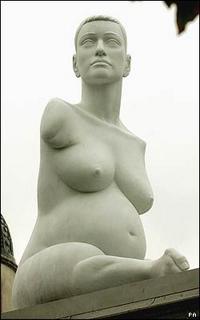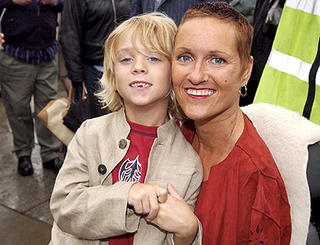Pregnant and disabled in public
No, this isn't really a follow-up to my earlier post, Pregnant in public. I just couldn't resist the urge to echo the title here.
 This is "Alison Lapper Pregnant", a statue currently on display in Trafalgar Square. It is an accurate representation (aside from its 16-foot height!), having been made from a plaster cast of Ms. Lapper's body.
This is "Alison Lapper Pregnant", a statue currently on display in Trafalgar Square. It is an accurate representation (aside from its 16-foot height!), having been made from a plaster cast of Ms. Lapper's body.Alison Lapper was born with no arms and only partial legs (the condition is called phocomelia). But in all other respects she is perfectly normal — including the capacity to conceive and carry a baby.
 Ms. Lapper often poses nude. I believe she conceived the concept for this photo herself (source).
Ms. Lapper often poses nude. I believe she conceived the concept for this photo herself (source).Ms. Lapper survived a very difficult start in life. She was raised in an orphanage where the staff terrorized the children. She would have been adopted into a loving home, but her mother put a stop to it for some reason. Eventually she got married, but her husband wanted only to abuse her. Heather Mallick tells the story:
- No family member on either side spotted anything wrong with him. … On their wedding night, he shut the door of their room and turned to her with an odd expression on his face. "You're mine now and you'll do as I tell you."
The greatest thing any woman should fear is a man who seeks to control. Imagine a man who feels the need to control even a limbless woman. Once, he started to pull her slowly off the kitchen table, mocking her as she approached the edge where she would fall and break her head open. Desperate, she bit his arm, drawing blood. She divorced him.
 Today, Ms. Lapper is an artist (she paints by holding a brush in her mouth) and the single mother of a five year old son, Parys. (After a brief relationship with an able-bodied man she says: "I quite unexpectedly, and quite happily fell pregnant, and he ran a mile". Source for the photo.)
Today, Ms. Lapper is an artist (she paints by holding a brush in her mouth) and the single mother of a five year old son, Parys. (After a brief relationship with an able-bodied man she says: "I quite unexpectedly, and quite happily fell pregnant, and he ran a mile". Source for the photo.)The statue will only be displayed in Trafalgar Square for eighteen months. Even so, it is causing some controversy. Some critics don't think it's art, or at least not very good art. And some members of the British public don't think the subject matter is suitably historic/heroic for Trafalgar square. Phil says:
- I think it's a cool statue, but I don't think it's right for here. All the other statues in the Square are of national heroes, so — no offence to her, because she's a great person and she's done some really good work — I think we should have another national hero up here.
- I think it’s brilliant. Where else in the world can you see a 16-foot sculpture of a naked, disabled, pregnant woman? The fact that a major work by a well-known English artist [Marc Quinn] is concerned with disability is a turnaround — though Parys is most upset that he’s in my tummy and you can’t see his face. I’m not a champion of the disabled world, but it’s a joy when people come over after seeing me on TV and say it really made them think.
- It's a really beautiful piece, and I think it makes you look at the body of the person very sympathetically. It's very rounded, very appealing. I think that's a lovely thing to bring that forward — when we don't normally think of a disabled person's body as being beautiful and aesthetically pleasing. It's an interesting coming together of an aesthetic artform with a body that you wouldn't normally look at it in that way. I find it really affirming. I'd certainly prefer to see this than more sculptures of war heroes."
 "I would pick Parys up by his clothes with my teeth and lay him across my shoulder. I breast-fed him for ten months with him in a sling across my chest. I've never been able to hold him in my arms, but we were very physical with one another, so we haven't missed out."
"I would pick Parys up by his clothes with my teeth and lay him across my shoulder. I breast-fed him for ten months with him in a sling across my chest. I've never been able to hold him in my arms, but we were very physical with one another, so we haven't missed out."

8 Comments:
Although I can appreciate the asthetics of the piece, and have no problems with the subject, indeed I have followed Alison Lapper's story on the BBC as she was part of a series following the developnment and upbringing children born in 2000 as her son Parys was (fascinating to see her overcome her difficulties).
I feel that a plinth in Trafalgar square isn't the place for this particular piece of sculpture and I would prefer to see something either a) more abstract, and b) something more pertaining to British History, considering it's location.
I would however still like this piece to be place prominently somewhere public, perhaps in one of the royal parks.
I disagree with mr A, & have said so on a number of other blogs that have raised this iussue (as you say, it has already caused some controvosy & debate over here).
The 4th Plinth in Trafalger SQ has been used to showcase prominent British Artists work for some years now. I am not totally in agreement that it is the correct place to do this, but since that is what it's for, I believe that Quinns piece has at least as much right to be there as anybody elses, and that the subject is a good thing to bring into the public view.
I should mention that I've made several changes to the post since the three of you commented. In fact, I don't know if I've ever fiddled with a post quite so much as I've fiddled with this one.
• Mr. & Mrs. Aginoth, I'm glad to have your British perspective on this issue.
Aginoth, I'm surprised you think an abstract piece would be suitable for Trafalgar Square. If your objection is that the setting has a historical significance of its own, I don't know why abstract art would be acceptable.
• Mary P., you'll be interested in the text I've added beneath the final photo, in which Ms. Lapper explains how she managed to breast-feed without any arms. Awe-inspiring indeed!
Q
Alsison Lapper & Parys (alongside 24 other British families of all types) are featured annually in A Child of Our Time A Documentary following the families from pregnancy till adulthood.
The children were all born in early 2000, so it's now just coming up for it's sixth year.
Fascinating viewing. I'm looking forward to January to see what worries we can have for Mstr A over the next year!
Just my own personal Preference I like Abstract art, not necessarily cubist, but something that pulls on our perception of form from the real appearance, no other reason :o)
Ok perhaps that's no reason for it not to be there, I'll concede that, however my preference for a piece representing an event from British History remains.
I do however still like the sculpture and congratulate both Quinn and Alison Lapper for this fine work
I wasn't familiar with this story. It is quite interesting.
I appaud Ms. Lapper and admire the art work. She is every bit a hero as anyone else honor in the park.
• Mrs. Aginoth:
Focussing on children born in 2000 was serendipitous for you, given the age of Mstr A.
• Aginoth:
I certainly prefer "Alison Lapper Pregnant" to some of the alternative proposals for the fourth plinth.
• Jack:
The story hasn't gotten much media attention in Canada, either, although I found a few Canadian sources during my research. It's understandable that the UK is particularly interested in it, but Alison Lapper's story is inspirational wherever one lives.
• Misanthrope:
I agree. Alison Lapper, with her everyday challenges, is easier for us to relate to than Admiral Nelson, with his naval triumphs.
Q
Post a Comment
<< Home